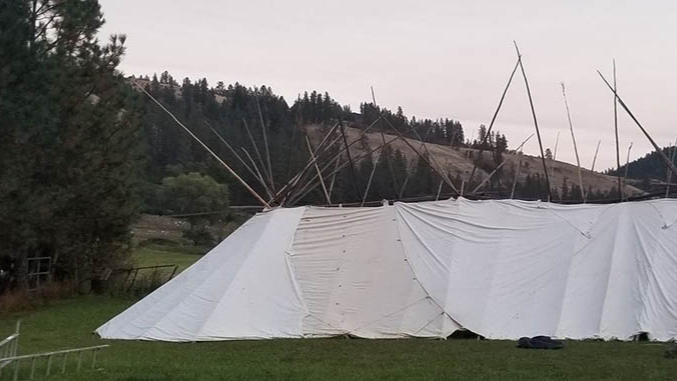Plateau Long Tent Coming to Whitman College

The Long Tent is an important element of Plateau culture and architecture. Photo courtesy of Roger Amerman.
Whitman College is partnering with the Confederated Tribes of the Umatilla Indian Reservation (CTUIR) to bring a Plateau Long Tent to campus. An important element of Plateau culture and architecture, the Long Tent will host a weeklong series of speakers and events, the first of its kind on a college campus, made possible through collaboration with the CTUIR Education Department, Tamástslikt Cultural Institute, Nixya'awii Community School and the Whitman Mission National Historic Site.
Members of the public and the press are invited to attend an opening ceremony following the historic construction of a Plateau Long Tent on Whitman College’s Ankeny Field on Monday, April 18, at 4:30 p.m.
Fully vaccinated visitors are welcome to take part in additional programming designed to deepen their understanding of the Walla Walla Basin and Native American communities in the area, including talks, panels and presentations throughout the week of April 18-24.
Unprecedented Opportunities
The Long Tent will be symbolically located near Treaty Rock, site of the Treaty of 1855 in which tribes were compelled to cede much of their ancestral territory to white settlers.
The presence of the Long Tent on Whitman’s campus is the culmination of many months of collaboration by the Long Tent Working Group, which comprises Whitman faculty, staff and students as well as members of local Native American communities. It builds on previous efforts to strengthen the relationship between Whitman and the CTUIR, including the landmark Memorandum of Understanding.
“The fact that we are establishing a piece of architecture like the Long Tent on a college campus in the United States is unprecedented and wonderful,” said Roger Amerman (Choctaw), a 1980 Whitman graduate and co-director of the event. “In modern times, you infrequently see the Long Tent architecture set up for only special events, and only in the Reservation communities. This will probably be the first and last time Whitman College students will see a long tent.”
In the Walla Walla Sahaptin language, the Long Tent is known as kwalk ineet and is distinct to Native American tribes of the Columbia Plateau. Traditionally, it is used as an extended family dwelling or community structure for lodging, social, ceremonial and religious activities at different times of the year. The Long Tent constructed at Whitman will be for educational rather than ceremonial purposes, with certain courses spending class time inside the Long Tent.
“It is difficult to overstate the significance of this project and the opportunities it presents to both our students and the wider community,” said Whitman Professor of Sociology and Associate Dean for Faculty Development Helen Kim, a member of the working group. “It combines experiential learning with the need for greater engagement with the complex history of our region, which has been a major point of focus for us in recent years.”
Tribal leader E. Thomas Morning Owl (Umatilla and Kainai) will be CTUIR elder-in-residence, while Hereditary Chief of the Walúulapam (Walla Walla people) and CTUIR executive director Donald Sampson will lead the opening ceremony. Dignitaries and elders from local Plateau tribes such as the Cayuse, Colville, Nez Perce, Umatilla and Walla Walla will also participate, including Kat Brigham, chair of the CTUIR Board of Trustees.